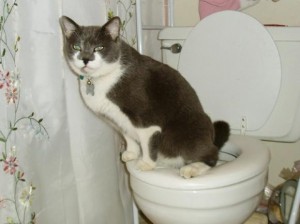Just how do you feel in regards to Can You Flush Cat Poo or Litter Down the Toilet??

Intro
As cat owners, it's important to be mindful of how we get rid of our feline pals' waste. While it might appear practical to purge feline poop down the commode, this technique can have destructive effects for both the setting and human health.
Environmental Impact
Purging pet cat poop presents unsafe virus and bloodsuckers right into the water system, presenting a substantial danger to water ecosystems. These contaminants can negatively affect marine life and compromise water quality.
Health Risks
In addition to environmental concerns, purging feline waste can additionally present health threats to people. Pet cat feces may contain Toxoplasma gondii, a parasite that can cause toxoplasmosis-- a possibly extreme health problem, particularly for expectant women and people with weakened immune systems.
Alternatives to Flushing
Fortunately, there are more secure and a lot more responsible ways to take care of cat poop. Think about the adhering to alternatives:
1. Scoop and Dispose in Trash
One of the most usual approach of getting rid of pet cat poop is to scoop it right into a naturally degradable bag and toss it in the garbage. Be sure to utilize a devoted trash scoop and throw away the waste without delay.
2. Usage Biodegradable Litter
Go with biodegradable feline trash made from products such as corn or wheat. These trashes are environmentally friendly and can be securely taken care of in the trash.
3. Bury in the Yard
If you have a backyard, consider burying feline waste in a designated area far from vegetable yards and water sources. Make sure to dig deep enough to avoid contamination of groundwater.
4. Install a Pet Waste Disposal System
Buy a pet dog garbage disposal system specifically made for feline waste. These systems utilize enzymes to break down the waste, decreasing odor and ecological effect.
Verdict
Accountable family pet ownership expands beyond giving food and shelter-- it also includes appropriate waste management. By refraining from purging feline poop down the commode and choosing different disposal methods, we can lessen our environmental footprint and secure human wellness.
Why Can’t I Flush Cat Poop?
It Spreads a Parasite
Cats are frequently infected with a parasite called toxoplasma gondii. The parasite causes an infection called toxoplasmosis. It is usually harmless to cats. The parasite only uses cat poop as a host for its eggs. Otherwise, the cat’s immune system usually keeps the infection at low enough levels to maintain its own health. But it does not stop the develop of eggs. These eggs are tiny and surprisingly tough. They may survive for a year before they begin to grow. But that’s the problem.
Our wastewater system is not designed to deal with toxoplasmosis eggs. Instead, most eggs will flush from your toilet into sewers and wastewater management plants. After the sewage is treated for many other harmful things in it, it is typically released into local rivers, lakes, or oceans. Here, the toxoplasmosis eggs can find new hosts, including starfish, crabs, otters, and many other wildlife. For many, this is a significant risk to their health. Toxoplasmosis can also end up infecting water sources that are important for agriculture, which means our deer, pigs, and sheep can get infected too.
Is There Risk to Humans?
There can be a risk to human life from flushing cat poop down the toilet. If you do so, the parasites from your cat’s poop can end up in shellfish, game animals, or livestock. If this meat is then served raw or undercooked, the people who eat it can get sick.
In fact, according to the CDC, 40 million people in the United States are infected with toxoplasma gondii. They get it from exposure to infected seafood, or from some kind of cat poop contamination, like drinking from a stream that is contaminated or touching anything that has come into contact with cat poop. That includes just cleaning a cat litter box.
Most people who get infected with these parasites will not develop any symptoms. However, for pregnant women or for those with compromised immune systems, the parasite can cause severe health problems.
How to Handle Cat Poop
The best way to handle cat poop is actually to clean the box more often. The eggs that the parasite sheds will not become active until one to five days after the cat poops. That means that if you clean daily, you’re much less likely to come into direct contact with infectious eggs.
That said, always dispose of cat poop in the garbage and not down the toilet. Wash your hands before and after you clean the litter box, and bring the bag of poop right outside to your garbage bins.
https://trenchlesssolutionsusa.com/why-cant-i-flush-cat-poop/

I hope you enjoyed reading our part about Don’t flush cat feces down the toilet. Thanks so much for taking a few minutes to read through our short article. Are you aware of another individual who is very much interested in the niche? Do not hesitate to share it. Thanks for taking the time to read it.
Schedule Free Estimate
Comments on “Avoid Clogs and Damage: Don't Flush Cat Poop Down Your Toilet - Professional Insights”